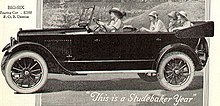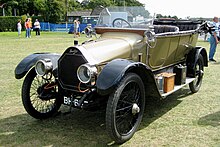Touring car
This article needs additional citations for verification. (November 2011) |

A touring car is an open car seating four or more. A popular car body style in the early twentieth century, it declined in popularity in the 1920s when closed bodies became less expensive.
A tourer, in Britain and the Commonwealth, is a similar vehicle; however, the term is sometimes used to describe pre-war two-seaters which, in US terminology, would be roadsters. The term "all-weather tourer" was used to describe open vehicles that could be fully enclosed.
A popular version of the touring car style was the torpedo, with the hood/bonnet line at the car's waistline giving the car a straight line from front to back. This eventually became the normal version of the touring car, and the term "torpedo" fell out of use, having been replaced by the hardtop.
Description

In 1916, the US-based Society of Automobile Engineers defined a touring car as: "an open car seating four or more with direct entrance to tonneau."[1] The term has also been defined as an open car seating five or more.[2] Touring cars may have two or four doors. Engines on early models were either in the front, or in a mid-body position.
Side curtains, when available for a particular model, could be installed to protect passengers from wind and weather by snapping or zipping them into place; otherwise, drivers and passengers braved the elements. When the top was folded down, it formed a bulky mass known as the "fan" behind the back seat: "fan covers" were made to protect the top and its wooden ribs while in the down position.
History

The touring car style was popular in the early 20th century, being a larger alternative to the runabout and the roadster. By the mid-teens in the United States, the touring car body had evolved into a variety of types, with the four-door touring car, equipped with a convertible top, being the most popular body style offered.
Most of Model T's produced by Ford between 1908 and 1927 were four and then three-door models (with drivers sliding behind the wheel from passenger seat) touring cars, accounting for 6,519,643 cars sold out of the 15,000,000 estimated Model T's built. In terms of percentage, the 5-passenger touring car model was Ford's most popular body type and accounted for 44% of all Model T's (cars, trucks and chassis) sold over the model's eighteen-plus year life span; Ford's second most popular body style during the same period was its Model T based truck.[citation needed]
The popularity of the touring car began to wane in the 1920s when cars with enclosed passenger compartments became more affordable, and began to consistently out-sell the open cars.[3]
Tourer (Britain and Commonwealth)

The British tourer, as an open car with minimal weather protection, is similar to the touring car, and the terms have been considered interchangeable;[4][5] However, not all definitions specify tourers to have four or more seats,[4][6]
"All-weather tourer" was used for open four-door cars with high quality tops and winding windows;[4] these vehicles were later called convertibles.[7]
In Australia tourers may have two or four doors. The belt lines of tourers were often lowered in the front doors to give the car a more sporting character.[6] and would then be named sports tourers.
Torpedo body

The torpedo body style was a type of touring body used from the early twentieth century until the mid-1920s. A torpedo's hood (bonnet) line was level with the car's waistline, giving a straight line from front to back.[8]
The torpedo body style was usually fitted to 4 or 5 seat cars and was a touring car with detachable or folding top (hood) and low side panels and doors, but no B pillars: the only uprights present were those supporting the windshield (windscreen).[citation needed]
The torpedo style became the normal style of touring car and the name fell into disuse around 1920.[5]
See also
- Barchetta – an Italian style of roadster or spyder developed for racing cars after World War II
- Phaeton body – similar to a touring car, but initially lighter and more sporting
- Runabout – a light, open two-seat car, similar to a roadster but with emphasis on economy instead of performance.
References
- ^ "What's What in Automobile Bodies Officially Determined" (pdf). The New York Times. New York, NY USA. Nomenclature Division, Society of Automobile Engineers. August 20, 1916. ISSN 0362-4331. OCLC 1645522. Retrieved 2012-05-31.
Here it is, with other body types and distinctions, officially determined recently by the Nomenclature Division of the Society of Automobile Engineers:
- ^ Stein, Jess, ed. (1975) [1968]. The Random House College Dictionary (Revised ed.). New York, NY USA: Random House. p. 1389. ISBN 0-394-43600-8.
touring car, an open automobile designed for five or more passengers.
- ^ Ullman, William (1930-01-19). "Show Reflects Car's Progress – Dawn of New Decade Finds Motordom Has Made Gigantic Strides". The Pittsburgh Press. Pittsburgh, PA USA. Automobile Section. Retrieved 2012-06-02.
Interest was centered in the development of low-priced closed models in every automobile factory in the country and the rapid decline of the open car was apparent on all sides.
- ^ a b c Georgano, G. N.; Andersen, Thorkil Ry (1982-10-21) [1973]. Georgano, G. N. (ed.). The New encyclopedia of motorcars, 1885 to the present (3rd ed.). Dutton. p. 685. ISBN 0-5259-3254-2. Retrieved 2012-08-12.
{{cite book}}: Cite has empty unknown parameter:|1=(help); Invalid|ref=harv(help) - ^ a b Georgano, G. N., ed. (1971). "Glossary". Encyclopedia of American Automobiles. New York, NY USA: E. P. Dutton. p. 217. ISBN 0-525-097929. LCCN 79-147885. Retrieved 2012-08-12.
- ^ a b Davis, Pedr., ed. (1986). The Macquarie Dictionary of Motoring. Sydney, Australia: Macquarie Library. p. 485. ISBN 0-949757-35-7.
- ^ Georgano & Andersen 1982, p. 683.
- ^ Roberts, Peter (1974). "Carriage to Car". Veteran and Vintage Cars. London, UK: Octopus Books. p. 111. ISBN 0-7064-0331-2.
Torpedo – Continental term for an open four-seat tourer with soft hood and sporting tendencies and in which the line of the bonnet was continued back to the rear of the car.


